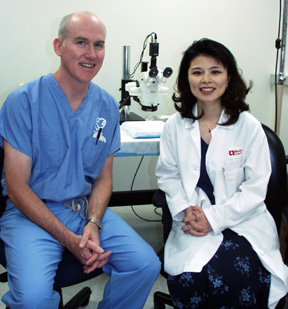A new discovery by a team of researchers at UNMC will be the featured cover story in the Sept. 3 issue of the Journal of Clinical Investigation, a peer-reviewed biomedical research journal published by the American Society for Clinical Investigation (ASCI). The two-year study was funded, in part, by a $1.3 million grant from the U.S. National Institutes of Health and a $300,000 grant from the American Heart Association.
 |
Wanfen Xiong, M.D., Ph.D., researcher, UNMC department of surgery and Timothy Baxter, M.D., principal investigator of the grant, as well as a vascular surgeon and professor in the UNMC department of surgery, are part of the team that made the new discovery. |
In the article, UNMC researchers are the first to show that the interaction between two enzymes plays an important role in the formation of abdominal aortic aneurysms. The results of the study show a shift in thinking, from what was once thought to be a simple, yet unknown process in the formation of aneurysms, to one that is more dynamic than previously thought, said Timothy Baxter, M.D., principal investigator of the grant, as well as a vascular surgeon and professor in the UNMC department of surgery.
The study
The team used mouse models to study two enzymes, matrix metalloproteinases (MMPs) 9 and 2. They used knockout mice — mice engineered without the enzymes — and normal mice, which contain the enzymes. They found that aneurysms did not develop in the knockout mice, but did in the normal mice.
“This research provides new insight into how aneurysms are formed,” Dr. Baxter said. “We found MMP 2 and 9 work together in forming aneurysms. MMP 9 and 2 are increased in human abdominal aortic aneurysm tissue. Our finding helps clarify their role, but we still have much to learn about the interaction of these enzymes.”
The team also tested the effect of doxycycline, a drug known to inhibit the activity of MMP 9 and 2. Mice treated with the drug showed a significant decrease in aneurysm growth.
Dr. Baxter said the discovery might ultimately give patients a way to prevent a small aneurysm from growing large enough to rupture.
“It’s a bad thing to have to tell someone they have a life-threatening problem, but we can’t do anything about it other than have them come in every six months for an ultrasound or CT scan, watch it and wait until it gets bigger before we recommend an intervention,” Dr. Baxter said. “If we can block MMPs with drugs, and this in turn inhibits aneurysm growth, it gives the patient the prospect of never requiring intervention.”
Next step: clinical trials
Based on this research and in conjunction with researchers from Northwestern University in Chicago and Washington University in St. Louis, the UNMC team has applied for NIH funding to conduct a clinical trial on a drug that inhibits MMPs and, hopefully, also inhibits the growth of aneurysms.
“Our goal is to define the biologic mechanisms of aneurysm formation,” said Wanfen Xiong, M.D., Ph.D., researcher, UNMC department of surgery. “From this study, we believe that matrix metalloproteinases 2 and 9 play an important role in the progression of aneurismal degeneration. Inhibition of those enzymes might provide a feasible means by which to suppress the progression of aneurysm growth.
“I love science and helping people,” Dr. Xiong said. “I am glad our findings may lead to development of mechanism-based pharmacologic strategies for aneurysm diseases.”
What is an aneurysm?
An aneurysm is a bulge in a blood vessel that occurs when the wall of the aorta (the main blood vessel in the heart that travels to the legs and abdomen) becomes weakened. This happens most commonly in the abdominal vessel that normally is about the circumference of a garden hose. The vessel in an aneurysm can get as big as a grapefruit before it ruptures, causing internal bleeding. About 16,000 people each year who experience ruptured aortic aneurysms, die.
Most people are unaware they have an aneurysm because there usually aren’t any symptoms until rupture occurs.
The research team
In addition to Drs. Baxter and Xiong, other authors of the study are: G. Matthew Longo, M.D., UNMC department of surgery; Timothy Greiner, M.D., UNMC department of pathology and microbiology; Yong Zhao, M.D., UNMC department of surgery; and Nicola Fiotti, Universita degli studi di Trieste, Trieste, Italy.